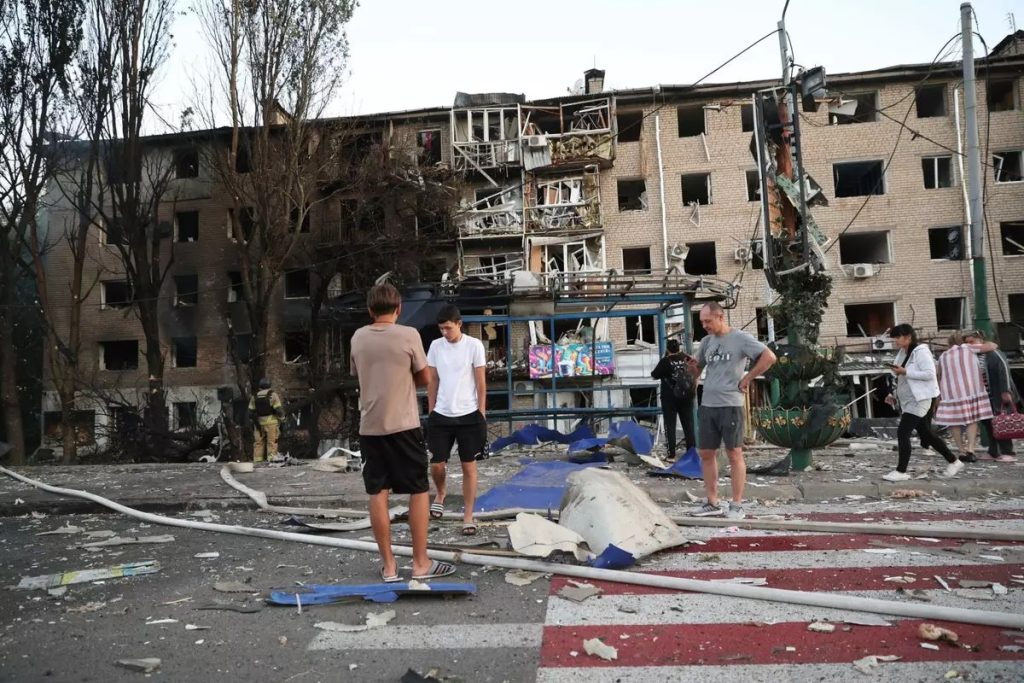Escalating Tensions: A Complex Tapestry of War and Diplomacy in Ukraine
In the midst of the ongoing conflict in Ukraine, recent actions and statements by global leadership have further complicated the already intricate political landscape. Notably, European Commission President Ursula von der Leyen recently echoed U.S. President Trump’s reassurance of an American presence in Ukraine as part of a broader international strategy to stabilize the region. She stated, “That was very clear and repeatedly affirmed.” This announcement follows a high-level meeting last month between President Trump, Ukrainian President Volodymyr Zelensky, and senior European leaders, emphasizing the West’s commitment to Ukrainian security amidst ongoing threats.
The Situation on the Ground in Ukraine
As diplomatic discussions unfold, the situation in Ukraine has remained dire. A series of relentless Russian drone strikes targeted power facilities over the weekend, leaving nearly 60,000 Ukrainians without electricity. President Zelensky vowed retaliation, indicating that Ukraine is preparing for “new deep strikes” aimed at critical infrastructure inside Russia. The president’s words reflect a determination to not only defend Ukraine but also to counterattack strategically amidst a backdrop of sustained aggression.
The attacks were particularly severe in the port city of Chornomorsk, where a combination of residential areas and administrative buildings faced damage. Governor Oleh Kiper reported extensive casualties and infrastructural damage, underscoring the urgent need for a robust response.
Key Developments and European Involvement
Recent developments highlight the evolving military and political landscape in Europe. Von der Leyen mentioned that Europe is formulating “pretty precise plans” for a multinational troop deployment to Ukraine. This contingent is expected to include tens of thousands of European-led troops, bolstered by U.S. capabilities, including advanced command, control, and surveillance systems.
Germany’s Chancellor, Friedrich Merz, voiced the perspective that peace must not come at Ukraine’s expense. In a recent interview, he emphasized that a quick resolution to the conflict that compromised Ukraine’s sovereignty is not a viable option. He reinforced that supporting Ukraine is of “absolute priority,” indicating that Germany will continue to provide substantial military aid, which has reached around $47 billion since the beginning of the full-scale invasion.
Ongoing Military Engagements
The conflict remains intensely militarized, with both sides executing aggressive strategies. Zelensky disclosed that Ukrainian forces have been ramping up their operations in response to increased Russian attacks. He noted that during a single night alone, Ukraine faced over 500 drones and 45 missiles, highlighting a pattern of intense aerial warfare that has characterized the conflict in recent weeks.
In reaction to ongoing attacks, Ukraine has also begun to take the fight to Russian territory. Reports indicate that president Zelensky has ordered missile strikes targeting infrastructure crucial to Russia’s military ambitions. These moves denote a shift from defense to a more offensive posture, aiming to disrupt Russian operations before they can evolve into larger threats against Ukraine.
Political Intrigues and Assassinations
Amidst war, instances of violent political strife within Ukraine have emerged. The recent assassination of Ukrainian politician Andriy Parubiy in Lviv has sent shockwaves through the political community. Parubiy was a prominent figure during Ukraine’s tumultuous Euromaidan protests in 2014 and played a significant role in pushing for closer ties with the European Union. The nature of his killing raises questions about internal stability and the potential ramifications of Ukraine’s ongoing conflict with Russia.
Ukrainian authorities announced the arrest of a suspect connected to the assassination, underscoring both the volatility of domestic politics and the interconnected nature of external aggression and internal strife.
International Responses and Talks
The international diplomatic response to the Ukrainian conflict is also evolving. Amid accusations that European nations are prolonging the war by waiting for a more favorable outcome in negotiations, some U.S. officials have expressed frustration with European leaders’ strategies. The Biden administration is contemplating a shift in approach, potentially taking a step back from active negotiation efforts until there is a clearer willingness from both sides to engage meaningfully.
With power dynamics shifting swiftly, President Trump’s engagement with leaders in Russia and Ukraine continues to attract scrutiny. His administration’s dealings reflect a dual approach of asserting American influence while navigating complex relationships with both allies and adversaries.
Conclusion
The current dynamics in Ukraine highlight the challenges and intricacies of modern warfare and diplomacy. As countries grapple with their roles in supporting Ukraine and countering Russian aggression, the future of the region remains uncertain. Each development underscores not only the immediate impact of military actions but also the long-term consequences for international relations and global security going forward.

